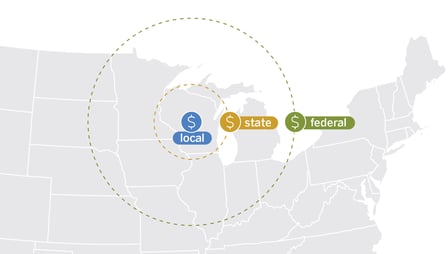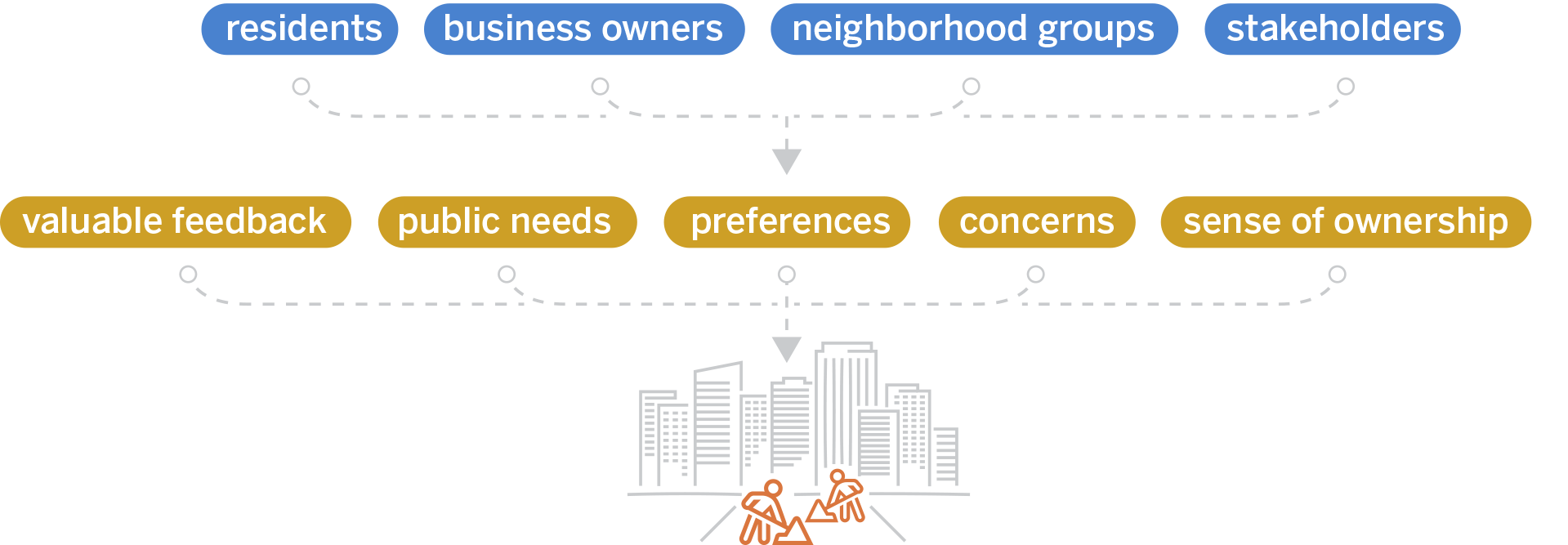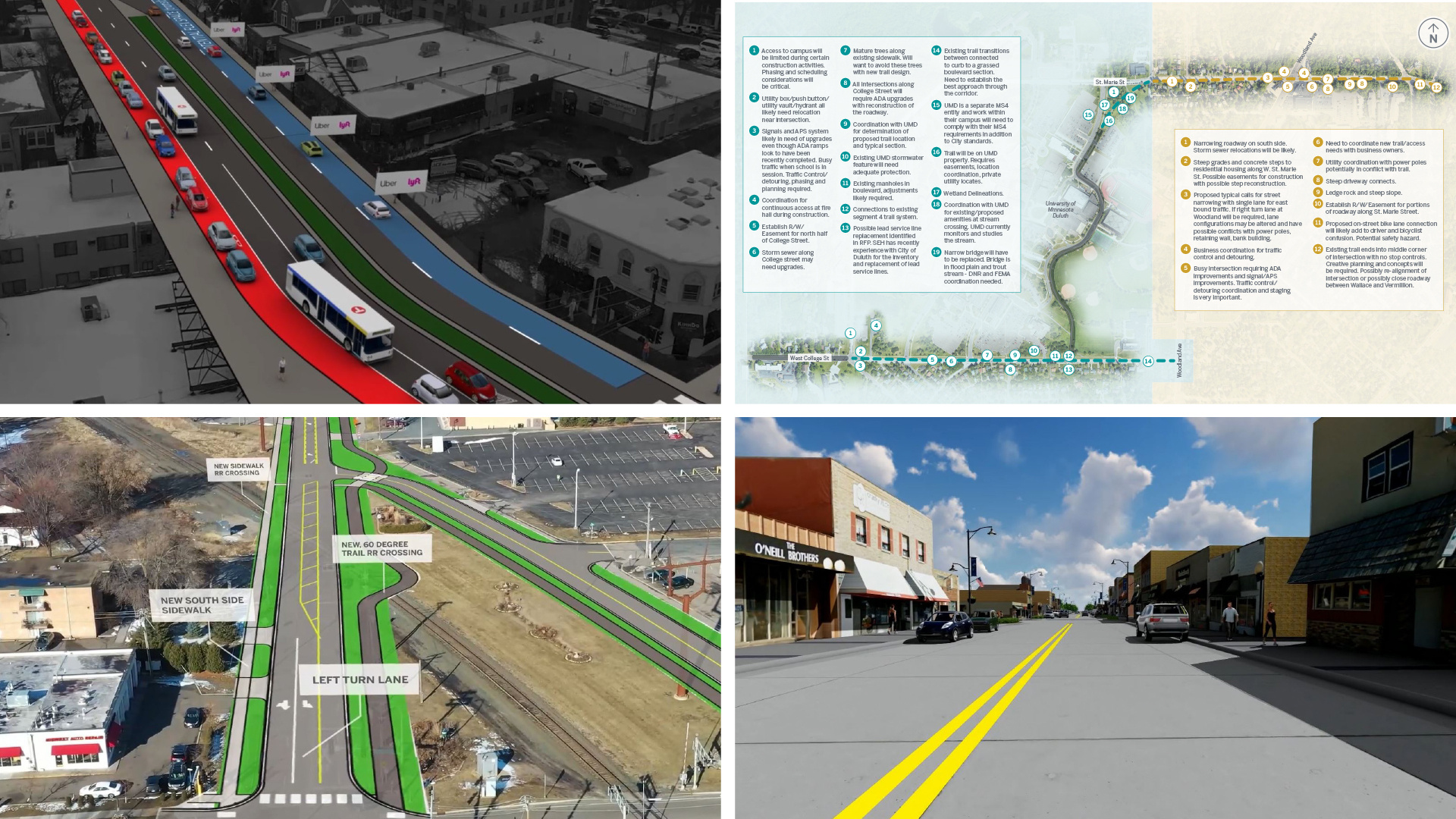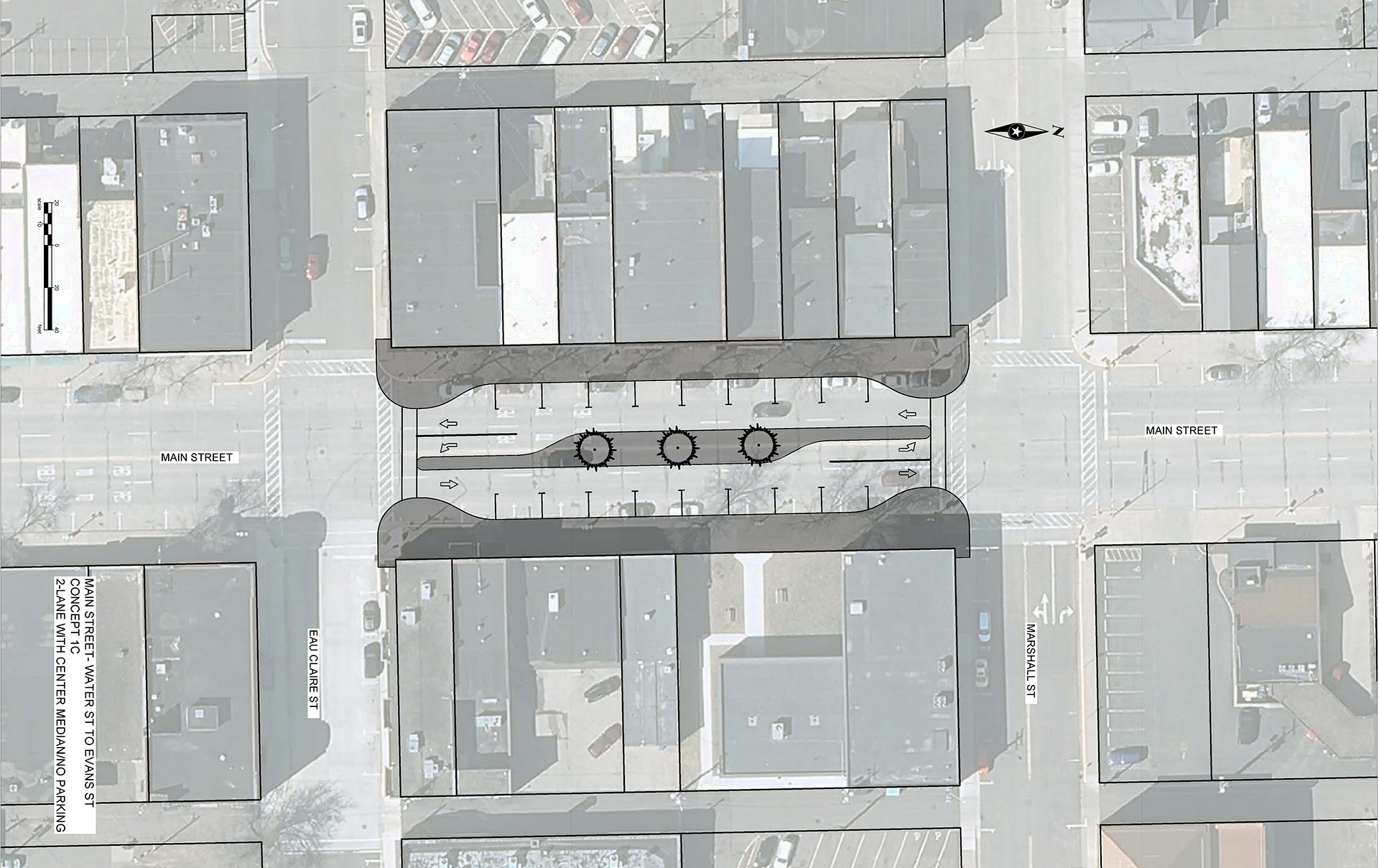More than a collection of buildings and services, a downtown or main street so often serves as the heart of our communities, bringing people together and establishing collective pride in our shared spaces.
Despite their importance, many downtowns no longer accommodate the changing needs of residents, business owners, city offices, and other stakeholders. They may become overloaded with traffic, making safety a concern, or a bit deserted, like an old western town with tumbleweeds rolling through. But like so many things that stand the test of time, outdated downtowns can be reinvigorated – thoughtfully redesigned to fit the current and future needs of your community, once again serving as a welcoming, vibrant city hub.
In this article, our experts offer practical tips with real-world examples from the SEH team highlighting two Wisconsin redevelopment projects facing different challenges, timelines, and desired outcomes:
 Shell Lake Downtown Redevelopment
Shell Lake Downtown Redevelopment Rice Lake Main Street Reconstruction
Rice Lake Main Street ReconstructionThese tips and examples will help give you a jumpstart to realistically reimagine your downtown while considering your own city’s unique characteristics, constraints, and goals.
Tip #1: Investigate funding sources and beneficial partnerships
No matter the size, any downtown revitalization project presents a substantial financial undertaking. Instead of shouldering the cost alone, exploring opportunities for funding sources and partnerships will help distribute the financial burden and form meaningful community relationships.

A variety of grant programs are available through local, state, and federal agencies. For example, the U.S. Department of Transportation (DOT) publishes funding notices. Be sure to check your state DOT website for additional resources, such as current lists of grants they are tracking. Tax Increment Financing (TIF) is another economic development tool that may be available in your state. While familiarizing yourself with applicable programs is key, working with a partner well-versed in researching and securing project funding is highly advantageous.
When first imagining what your project might entail, consider other stakeholders, or potential stakeholders, who will be impacted. This may include local businesses, county or state agencies, and additional privately held organizations. You may find they want to be involved, and a mutually beneficial collaboration can be formed. These organizations may also bring in outside funding sources you hadn’t considered or had access to.
![]() Shell Lake’s downtown reconstruction was a collaboration between the City, County, and Indianhead Medical Center, a private critical-access hospital. The project involved expanding the hospital and consolidating the County’s health and human services into one central location adjoining the existing government center. It received multiple grants, including a $250,000 Community Development Investment Grant from the Wisconsin Economic Development Corporation and a Wisconsin DOT Multimodal Local Supplement grant. By leveraging public and private partners with similar goals, this project became financially feasible.
Shell Lake’s downtown reconstruction was a collaboration between the City, County, and Indianhead Medical Center, a private critical-access hospital. The project involved expanding the hospital and consolidating the County’s health and human services into one central location adjoining the existing government center. It received multiple grants, including a $250,000 Community Development Investment Grant from the Wisconsin Economic Development Corporation and a Wisconsin DOT Multimodal Local Supplement grant. By leveraging public and private partners with similar goals, this project became financially feasible.
Speaking to the collaborative nature of the partnership, the City vacated street right-of-way and gave two street blocks to the County and hospital, which was a win-win as Shell Lake now had fewer streets to maintain and there was greater space for project expansion. Additionally, as part of the redevelopment, a whole City block needed to be leveled. The homeowners impacted were bought out, but one very civic-minded homeowner decided to donate their home and lot to the City. So you never know when partnerships may lead to unexpected beneficiaries.

![]() The City of Rice Lake received over $3 million in grant funding from the Wisconsin Department of Administration’s (DOA) Neighborhood Investment Fund to replace their 50-year-old Main Street, which covered about half of the project cost.
The City of Rice Lake received over $3 million in grant funding from the Wisconsin Department of Administration’s (DOA) Neighborhood Investment Fund to replace their 50-year-old Main Street, which covered about half of the project cost.
Tip #2: Engage the public early for increased buy-in

Since your downtown redevelopment is all about community, engaging residents, business owners, neighborhood groups, and other stakeholders is essential. Early engagement presents a key opportunity to gain valuable feedback and consider public needs, preferences, and concerns while there is still time to make changes. This will give your community members a sense of ownership in the project, and they will be more likely to help move the redevelopment forward if roadblocks arrive down the line. Additionally, initiating this process often creates a greater sense of trust and collaboration among the project teams and stakeholders.

There are many ways to engage the public, and deploying several methods is best to reach the widest audience. Consider approaches like surveys, focus groups, workshops, in-person and virtual public meetings, flyers, and online platforms. Depending on your community demographics, you may want to present the information in multiple languages. No matter the engagement tactic, using creative, interactive tools like maps, models, drawings, VR visualizations, and other renderings can help bring your vision to life and sell the overall concept. Plus, making sure your community members feel heard and that the redevelopment reflects their vision and values will help pave the way for future projects.
![]()
 Many public involvement efforts were utilized to engage the community in Rice Lake’s Main Street revitalization. The project team held three public informational meetings and conducted three public surveys to gather input from various stakeholders, including the chamber of commerce and Main Street Association, helping create a conduit to the community. A robust website was created to keep the public informed about the project. It included weekly progress updates, design options, traffic study results, and 3D renderings using actual businesses to show how the new Main Street would come to life with increased vitality. Information and updates were also distributed through social media, which helped establish trust and transparency. This reconstruction enjoyed tremendous public support, thanks to the multifaceted engagement efforts from the start.
Many public involvement efforts were utilized to engage the community in Rice Lake’s Main Street revitalization. The project team held three public informational meetings and conducted three public surveys to gather input from various stakeholders, including the chamber of commerce and Main Street Association, helping create a conduit to the community. A robust website was created to keep the public informed about the project. It included weekly progress updates, design options, traffic study results, and 3D renderings using actual businesses to show how the new Main Street would come to life with increased vitality. Information and updates were also distributed through social media, which helped establish trust and transparency. This reconstruction enjoyed tremendous public support, thanks to the multifaceted engagement efforts from the start.

Related Content: 5 Ways to Engage Stakeholders and Get Your Community Behind a Project
Tip #3: Explore multiple design options
Whether you plan to work within your existing downtown layout or are ready to start from scratch, plan to consider a variety of designs and configurations. Keeping the goals of your redevelopment in mind will be key to selecting a design that meets your community’s needs, and it may be a plan you hadn’t previously considered. Starting with several options will allow you to compare the advantages and disadvantages of each, including costs, impacts, benefits, and trade-offs. Exploring additional factors like aesthetics, accessibility, sustainability, and functionality is also important during this process. Depending on how your city has grown and changed, you may find that streets, green spaces, or structures need to be moved, redeveloped, or can remain largely intact. Don’t rule anything out right away, and work with a design partner who understands your distinct requirements.
![]() After considering multiple designs, the Shell Lake team decided the best option to supplement the hospital and consolidate health and human services, which were previously spread throughout the county, was to vacate two City streets, essentially reconfiguring the downtown to accommodate the hospital expansion and create a County campus with a new health and human services building connecting to the government center.
After considering multiple designs, the Shell Lake team decided the best option to supplement the hospital and consolidate health and human services, which were previously spread throughout the county, was to vacate two City streets, essentially reconfiguring the downtown to accommodate the hospital expansion and create a County campus with a new health and human services building connecting to the government center.
A unique aspect of the reconfiguration was the County and hospital swapping areas of property so the hospital’s helicopter pad could be relocated to the same side of the street as the hospital, making the patient transport process much safer and more efficient.
Tip #4: Manage traffic, parking, and pedestrian concerns
A crucial aspect of any downtown redevelopment is finding the right balance between traffic, parking, pedestrian, and other multimodal travel needs – ensuring your downtown is safe, accessible, and inviting for everyone. As you assess current and future necessities, utilizing tools like public input surveys and traffic studies will help inform how you can improve the flow of people and vehicles in the area. Being open to creative solutions like different parking configurations, turn lane options, and pedestrian-only areas will also be beneficial.

![]() In Shell Lake, the removal of one City street to accommodate the new County campus was a benefit for pedestrians, as they no longer had to worry about navigating traffic in the area. On the other hand, since more employees were coming to work in the new health and human services building, additional parking was also a need. The solution was to rebuild a nearby City street to allow for angled parking, doubling the number of spaces parallel parking allowed. Though this was a greater cost to the City, and meant more upkeep, parking was a priority – making the benefits outweigh the expense.
In Shell Lake, the removal of one City street to accommodate the new County campus was a benefit for pedestrians, as they no longer had to worry about navigating traffic in the area. On the other hand, since more employees were coming to work in the new health and human services building, additional parking was also a need. The solution was to rebuild a nearby City street to allow for angled parking, doubling the number of spaces parallel parking allowed. Though this was a greater cost to the City, and meant more upkeep, parking was a priority – making the benefits outweigh the expense.
![]() Rice Lake’s four-lane Main Street wasn’t pedestrian friendly, and safety was a concern. The City conducted a traffic study and decided there was a need to calm traffic and reduce speeds. To meet this goal, the street was reduced to one lane in each direction with protected turn lanes added. The final design also included bump outs at intersections, narrowing the distance for pedestrians to cross, two signalized crossing lights that comply with ADA safety standards, and a wider urban shoulder that protects people exiting their cars and serves as a bike lane.
Rice Lake’s four-lane Main Street wasn’t pedestrian friendly, and safety was a concern. The City conducted a traffic study and decided there was a need to calm traffic and reduce speeds. To meet this goal, the street was reduced to one lane in each direction with protected turn lanes added. The final design also included bump outs at intersections, narrowing the distance for pedestrians to cross, two signalized crossing lights that comply with ADA safety standards, and a wider urban shoulder that protects people exiting their cars and serves as a bike lane.

Tip #5: Consider infrastructure replacement and sustainable practices
An often unseen but important aspect of a redevelopment project is the infrastructure needed to support it. While this can be an expensive and disruptive undertaking, it also presents an opportunity to improve efficiency and sustainability. When looking at funding and design options, consider the age of your water pipes, sewer lines, electrical systems, and other utilities that may need to be replaced or upgraded. Within your funding parameters, there may be a range of sustainable practices and materials available, such as LED streetlights, rain gardens, permeable pavement, and solar panels to reduce energy needs and environmental impacts. A redevelopment is the ideal time to invest in infrastructure and sustainable systems, ultimately setting your downtown up for long-term success.

![]() Shell Lake’s aging sanitary sewer lines were rerouted, reconstructed, and brought up to date. To help manage stormwater efficiently and handle increased runoff, bioretention storm sewer treatment devices were installed. Built right at the source, instead of transferring water to a larger pond, the devices help the system mimic existing runoff conditions and stay within the limited stormwater rates, even with the new development. While this sustainable option was an additional up-front cost, the expense is offset over time. Additionally, the City saved funds when the downtown reconfiguration allowed one block of water main to be removed, with no replacement needed.
Shell Lake’s aging sanitary sewer lines were rerouted, reconstructed, and brought up to date. To help manage stormwater efficiently and handle increased runoff, bioretention storm sewer treatment devices were installed. Built right at the source, instead of transferring water to a larger pond, the devices help the system mimic existing runoff conditions and stay within the limited stormwater rates, even with the new development. While this sustainable option was an additional up-front cost, the expense is offset over time. Additionally, the City saved funds when the downtown reconfiguration allowed one block of water main to be removed, with no replacement needed.
Tip #6: Include trees and greenery in the streetscape
When it comes to noticeable features, trees, greenery, and other natural elements have a huge impact on how residents and visitors perceive the downtown atmosphere. Not only do they add visual interest, beauty, and shade, they provide a sense of well-being that entices people to linger longer in the area. Options to include trees and greenery in your streetscape include planting along sidewalks, medians, or plazas. You can even take the greenery off the ground by creating green walls, roofs, or balconies.

Working with a landscape architect knowledgeable of the plants that will thrive in your particular area is essential, and they will be able to identify opportunities to use native plants, flowers, and grasses to further add a sense of place to your downtown indicative of the surrounding natural landscape. Several sustainable planting practices can be utilized to increase the lifespan of your trees, and incorporating greenery provides a number of environmental and economic benefits, such as reducing air pollution, stormwater runoff, noise, and heat island effects. Since these natural elements create a more inviting atmosphere for people to visit and stay, tourism and business activity often increase.

![]() When redeveloping Main Street, Rice Lake wanted to create a sense of placemaking – a welcoming environment for people to gather, socialize, and support surrounding businesses. A key feature of this placemaking effort was replacing the existing trees with species that were disease tolerant and added to the overall street aesthetic. The City used innovative tree cells during the planting. These are structures that provide space and support for roots to grow without impacting the surrounding infrastructure with overgrowth, which can often damage nearby sidewalks and pavement. Tree cells not only set the planting up for long-term lifecycle success, they allowed the City to avoid relocating a 6-inch steel gas main that ran along the street. With the added placemaking efforts, Rice Lake now has a more sustainable, attractive Main Street for people to utilize.
When redeveloping Main Street, Rice Lake wanted to create a sense of placemaking – a welcoming environment for people to gather, socialize, and support surrounding businesses. A key feature of this placemaking effort was replacing the existing trees with species that were disease tolerant and added to the overall street aesthetic. The City used innovative tree cells during the planting. These are structures that provide space and support for roots to grow without impacting the surrounding infrastructure with overgrowth, which can often damage nearby sidewalks and pavement. Tree cells not only set the planting up for long-term lifecycle success, they allowed the City to avoid relocating a 6-inch steel gas main that ran along the street. With the added placemaking efforts, Rice Lake now has a more sustainable, attractive Main Street for people to utilize.
Related Content: The Power of Trees in Shaping Sustainable Urban Places / Sustainable Urban Streets: 7 Tips for Successful Green Design
Tip #7: Create a realistic timeline
While exact timelines can and often will change over the course of any project, creating a realistic timeline that considers pressing needs, stakeholder expectations, and overall complexity is an important place to start. A practical schedule allows you to manage risks, communicate effectively, and account for factors such as funding, design options, public engagement, regulatory approvals, environmental impacts, utility coordination, phasing, and post-construction evaluations. This will also help you identify and get ahead of potential delays and conflicts that may arise. Each project is different depending on the scale, scope, and numerous other factors – what you don’t want to do is overpromise and underdeliver.
![]() Due to the space constraints on the hospital and need to centrally locate the County’s health and human services, Shell Lake’s downtown redevelopment was devised and implemented on an expedited timeline. While this project arose quickly out of necessity, thorough planning and due diligence first took place. The City, County, hospital, and project team worked together to outline a timeline of six months of planning followed by phased construction over two full years. From planning to completion in less than 3 years, the project accomplished all hospital and community goals, delivering a safe, accessible, and bustling downtown campus.
Due to the space constraints on the hospital and need to centrally locate the County’s health and human services, Shell Lake’s downtown redevelopment was devised and implemented on an expedited timeline. While this project arose quickly out of necessity, thorough planning and due diligence first took place. The City, County, hospital, and project team worked together to outline a timeline of six months of planning followed by phased construction over two full years. From planning to completion in less than 3 years, the project accomplished all hospital and community goals, delivering a safe, accessible, and bustling downtown campus.
![]() Rice Lake’s Main Street reconstruction was over a decade in the making. After an extensive amount of preplanning, once the project secured funding, execution moved along rapidly. In less than one year of construction over a single phase from April through December, Main Street was up and running, delivering a new, more pedestrian and business friendly atmosphere for the community to enjoy.
Rice Lake’s Main Street reconstruction was over a decade in the making. After an extensive amount of preplanning, once the project secured funding, execution moved along rapidly. In less than one year of construction over a single phase from April through December, Main Street was up and running, delivering a new, more pedestrian and business friendly atmosphere for the community to enjoy.
Bonus Tip: Imagine the big picture
As a bonus, here are eight additional components to consider when reimagining the look, feel, and overall environment of your downtown. Since this area serves many purposes for a wide variety of stakeholders, it must be comprised of multiple characteristics. While this list is not exhaustive, and implementing all elements is not essential for a successful downtown, taking the time to explore each of these features will help you see the whole picture rather than focusing on a single element or need.
Characteristics to consider:- Density of businesses
- Variety of services and businesses
- Day and night life
- Residential base
- Walkability
- Public gathering spaces
- Building and sign aesthetic cohesion
- Large regional draw
Ready, set, reimagine!
Whether you have a decade to design your ideal revitalization or need to implement more immediate updates, with proper planning your downtown can provide real, long-term community benefits. And if you're ready to start reimagining and could use some inspiration or guidance, our team is here to help.
About the Experts

Mike Van Gilder, PE*, is a senior civil engineer, project manager, and client service manager. He has extensive civil engineering design and construction experience, bringing expertise in municipal engineering, site development, erosion control, system modeling, and stormwater management. Over the course of his career, Mike has developed the ability to successfully lead a wide variety of projects. He has worked with numerous public and private clients throughout Northwest Wisconsin and the broader Midwest.
*Registered professional engineer in WI, MN

Virginia Torzewski is a graduate landscape architect with experience creating schematic design layouts, designing landscape plan sheets, developing planting plans and schedules, and modifying landscape details. She has developed graphics for promotional and diagrammatic purposes for projects including improved neighborhood utilities and water management, streetscape improvements, and stream naturalization.

Karl Weissenborn, PLA*, CLARB, ASLA, is an SEH senior landscape architect and project manager who leads complex and sustainable streetscape projects in both public and private sectors. He has extensive experience in leading complex projects from planning to design, with a focus on stakeholder engagement and environmental solutions. He is adept at handling challenging and budget-conscious projects, delivering high-quality outcomes that meet client needs and expectations.
*Registered landscape architect in KS, MN, MI, ND, IA, SD



